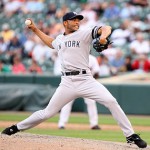Your Nats are on a little roll; they swept the Padres and have clawed their way to a mighty 4 games above .500 before looking downright weak so far in Philly. What’s the temperature of Tom Boswell‘s chat this week? Lets find out?
As always, I write the answer here before reading Boswell’s, and edit questions for clarity/conciseness.
Q: Is this the turnaround we’ve all been waiting for?
A: Well, at the risk of being a complete hypocrite (as a couple of my friends accuse me of doing, after basically writing off the team when they were still mired at .500 at the end of June), I’ll stick with “we’re not out of the woods yet.” After winning 4 straight and sweeping the hapless Padres in Washington, we travel to Philadelphia for a mid-week 4-game set where I only give the Nats the clear starting pitcher advantage in one of the four games.
And sure enough, Dan Haren gave up 2 early runs to set the tone and the Nats were efficiently shut down by former Ace John Lannan in dropping the first game 3-2 while getting just one run in 8 innings against Cole Hamels in last night’s loss. It would not surprise me in the least to see the Nats lose 3 of 4 in Philly (the mano-y-mano Cliff Lee-Gio Gonzalez showdown tonight favors the Phillies, then the Jordan Zimmerman–Kyle Kendrick matchup that favors Washington on paper .. but Zimmermann has been leaking runs lately and only has 4 quality starts in his last 8 outings). Boswell says that “baseball hates a straight line,” I suppose implying that the Nats can get a winning streak together and get back in.
Q: Why are the Nats ownership pushing out Johnson?
A: Asked and Answered in a previous chat. See the Davey Johnson question from the 7/1/13 version of this post. Boswell indeed repeats his 7/1 answer today.
Q: Who gets demoted to make way for Scott Hairston?
A: The obvious and easy answer is (and was) Tyler Moore, the only real expendable hitter left on the active roster. Expendible meaning he wasn’t a vet, wasn’t out of options, and isn’t hitting .300 playing every day. (This move has already happened by the publication of this post, so it isn’t very timely). Boswell points out that not only is Moore going to AAA, but there’s literally no room for him NEXT year since Scott Hairston is signed through 2014. Oops. Moore is now officially trade bait.
Q: Why do Baseball fields continue to be irregularly shaped?
A: Anachronism. Its the only thing I can think of. Boswell sort of agrees.
Q: Why havn’t we pulled the plug on Dan Haren?
A: I’ll give you $13M reasons why. But, we’re getting close. If the Nats are really going after Matt Garza then Haren’s days are numbered. Thank baseball for guaranteed contracts, eh? Boswell proposes a crazy trade proposal: Detwiler, Espinosa, Moore and Giolito for David Price, who he constantly mentions as being a guy he’d love to see acquired. I don’t see it; Tampa Bay is notoriously difficult to deal with on the trade market and this trade offer basically collects three under-performing MLBers and an injured rookie for one of the 15 best arms in the game. As David Schoenfield put it in his ESPN chat yesterday, this is a ridiculous trade offer from a homer-fan in Boswell.
For what its worth, later on in the chat someone also pokes disbelief at this trade proposal. Boswell defends the trade more on the years-of-control and by comparing Price to the Gio Gonzalez deal.
Q: Why did the Nats acquire Hairston in the first place?
A: Clearly, they felt like they needed better bench hitters. And, they got him. Boswell notes his great lefty splits.
Q: Will the Nats re-align their rotation post All-Star Break?
A: Probably; they did minor tweaks last year. Unless it results in some ridiculous layoff, you’d have to think they’re going back to the opening day 1-2-3-4-5. Boswell says nobody knows.
Q: According to high placed sources, Cliff Lee has informed the Phillies he’ll waive his no trade clause for the Nationals. Will the price be to high?
A: Ugh. Just go look at Cliff Lee‘s contract. He’s owed more than $75M AFTER this season (I’m counting the 2016 option that seems very likely to vest). He turns 35 in August. That’s an awful lot of money to be going to a 38 year old guy. And it’d take a massive haul of our thinned farm system to get him, since the Phillies would be full bore into rebuilding mode if they moved Lee. Just don’t see it. Yes Lee has been great this year, but the fall-off for guys in their mid 30s can be steep. Boswell points out similar facts.
Q: MLB seems to be making a special effort to promote Puig for the final spot, three tweets about him yesterday; none about the other four NL candidates. If they want him that badly why not institute a next-to-last spot for whoever they want to pick for marketing purposes?
A: Others have proposed reserving an all-star spot for an “Up and coming” player who isn’t on the ballot and thus has little chance of making it. That makes sense to me. MLB is doing their best to capture the Yasiel Puig-mania, and good for them to finally do some aggressive marketing of their marketable stars. Boswell says Puig is awesome and then goes off on a tangent.
Q: Is Rafael Soriano turning into Don “fullpack” Stanhouse for Davey Johnson?
A: Rafael Soriano‘s numbers are fine; 2.19 ERA, converted 21 of 24 save opportunities. He gives up a hit an inning; not ideal for a closer but not out of the realm of crazy. I don’t get THAT nervous when he comes into games. Boswell says Soriano is underrated.
Q: Alex Rodriguez is playing single A ball. Are the Yankees sending him a message?
A: Did the Nats “send a message” to Bryce Harper by sending him to Potomac (A-Ball) to rehab? MLBers have to play re-hab ball somewhere; dumb question inspired by the media sensationalism that perpetually surrounds Alex Rodriguez. Boswell pokes fun at the Yankees, Brian Cashman‘s STFU tweet and the whole situation with A-Rod in general.
Q: Do the Nationals over-play music and promotions at games?
A: The question comes from someone who clearly comes across as a whiny “I liked it in the old days when we just had an organ at baseball games” type. I’ve never gotten that impression at Nats games. If you want to *really* see what a fan experience is like with near perpetual distractions and music, just head on over to the Verizon Center and take in a Wizards games. They play 95 decibel music DURING PLAY. Its just crazy. Boswell says that while the PA is too loud, the Nats park is relatively devoid of ads and clutter.
Q: Trade proposal: Clippard and Storen for Cliff Lee
A: Two non-closers for a MLB Ace. And one (Drew Storen) who is really struggling this year. Yea right. If you’re going to propose trades, make them at least believable. boswell falls back on intra-division, CYA blocking reasons for not considering this trade.
Q: Should we prevent Harper from participating in the Home-Run Derby due to injury concerns?
A: Should we block Harper from taking batting practice due to injury concerns? Another ridiculous question. The Home Run Derby is just BP with the cameras on. Boswell says its more likely to mess up h is stroke; whatever. Everything I’ve read about Harper’s BP sessions show that he’s basically trying to hit it to the beer stands on every pitch.
Q: Does Storen need a change of scenery?
A: Great question; the full text of the question answers things pretty well; Storen has gone from closer to 7th inning Ryan Mattheus replacement in less than a half a season. If traded and given another shot, you have to think he’d re-flourish as a closer. Mike Rizzo has traded closer-quality guys to teams that covet them (see the Matt Capps deal) so maybe this could be in the cards. I’d always trade in a closer for a position player, since you can “make” closers so easily. Look at what Ian Krol is doing; all he’s done since arriving as an unheralded AA-reliever is just shut people down; I’ll bet he would make an excellent closer. Boswell says the team wants Storen around for the long haul.
Q: Trade idea: Danny Espinosa for Ervin Santana?
A: Hmm. #2 starter with a 2.93 ERA for a team trying to make the playoffs for …. an AAA infielder who hit .158 this year. AND the questioner thinks the Royals would throw in a prospect to make it work! Talk about over-valuing your own assets. There’s a difference between potential talent and realized talent; Espinosa completely encapsulates the difference. Yes we know that he’s a plus-plus defender who can hit 20 bombs from the shortstop position. But he has regressed year to year at the plate and now will be lucky to play in the majors again before the Sept 1st callup. Why would the Royals possibly do this deal? Thank god this is just a local chat and not one of these national ESPN chats where Nats fans in general would be lampooned for trade ideas like this. Boswell doesn’t really even give an opinion on this one.







